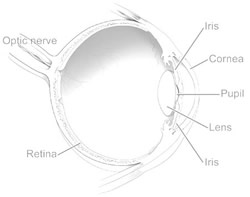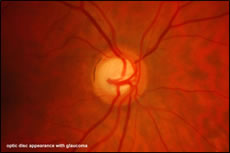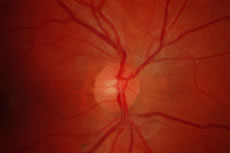Glaucoma Awareness Week 8th - 14th March 2010
Glaucoma - "The Sneak Thief Of Sight."
Glaucoma is the second most common cause of blindness worldwide.
"One of many reasons to have regular eye examinations."
Why the strange nick-name?
Glaucoma can be referred to as 'the sneak thief of sight' because in many cases it doesn't show symptoms to the sufferer immediately. This means that you could have this particular disease and not even be aware of it progressing. If left untreated, Glaucoma can cause devastating sight loss and once this damage has occurred it is irreversible.
What is Glaucoma?
Glaucoma is a disease in the eye that affects how visual information is carried along the Optic Nerve to the brain. There are many types of Glaucoma which affect various parts of your vision.
 Low Tension Glaucoma – This occurs when the peripheral vision is damaged though the pressure is within the normal limits.
Low Tension Glaucoma – This occurs when the peripheral vision is damaged though the pressure is within the normal limits.- Primary Open Angle Glaucoma – This is the most common variation of Glaucoma and only causes noticeable symptoms when it's fairly advanced.
- Closed Angle Glaucoma – This is a rapid painful rise in pressure in the eye. Most people who develop this tend to go to casualty.
- Sub Acute Angle Closure Glaucoma – This is difficult to diagnose as the symptoms and signs are not always present.
How is Glaucoma Diagnosed?
In order to detect Glaucoma you need to attend routine eye examinations and under-go a couple of tests. These tests are performed by our professional Optometrist, Sarah Gibson.
To measure the pressure in your eye Optometrists, such as Sarah Gibson use an instrument called a tonometer. There are TWO methods of tonometry. This measures the pressure in your eyes which is important when diagnosing Glaucoma.
- Non-Contact Tonometers – Commonly known as the "puff test". The "puff test" is the method most high street opticians use.
- Contact Tonometers – This method generally requires the optometrist to put anaesthetics drops into your eye before the pressure can be measured. At Sarah Gibson Optometrist we use this method to test the pressure because the “puff test” can be quite unpleasant. Contact tonometry is also considered to be more accurate.
Sarah will then take a fundus photograph of your eye. This is a digital photograph that allows Sarah to see the back of your eye clearly and perform a more thorough examination. Below are examples of what your eye can look like to Sarah.
Fundus Photograph Demonstration
 |
 |
| This picture demonstrates what the back of an eye may look like if you suffer with Glaucoma | This picture shows what a healthy eye is likely to look like |
We keep a record of all your fundus photographs. This means Sarah can detect any subtle change/deterioration because she has a photographic history of your eye’s health and she can compare each image.
Sarah will also measure your peripheral (the area of vision which lets you see objects out of “the corner of your eye”) vision. Sarah tests this by using a field screener analyzer. This too is a painless procedure and only takes a few minutes.
During this test you will be asked to look at a central target whilst small lights are flashed around it. When you think you’ve spotted a flashing light you need to press the buzzer. This tracks when you saw the light and whether any of them went unnoticed. Sarah can use these results to conclude whether there are any problems with your peripheral vision.
All of these tests are optional but recommended. By having these tests Sarah can perform a more thorough eye examination and monitor the health of your eyes and your vision to the highest standard.
Who is more likely to develop Glaucoma?
The risk of Glaucoma increases with age or if you take a high prescription of some medication. Also, if you have a close relative who suffers from Glaucoma then you are considered to have an increased risk of developing the disease yourself. This is why Sarah will ask you questions about medication and about your family history.
Is it true people who have Glaucoma or a relative with the disease get free eye tests?
In a way, yes. If you have Glaucoma then the NHS will pay for you to have an eye examination every 12 months. Also, if you are over the age of 40 and have a direct relative (parent/sibling/child) with Glaucoma then you are also eligible for an annual NHS sight test.
Currently, the NHS only fund Optometrist’s for basic sight tests. Unfortunately, this means that there is a small fee for the fundus photograph. However, the pressure check and filed check are performed free of charge.
For more information about your eyes you can visit the practice website: www.sgoeyecare.co.uk/
Sarah Gibson Optometrist
Commerce House
Market Place
Wincanton
Somerset
BA9 9JU
01963 34333
Comments
Login to comment!